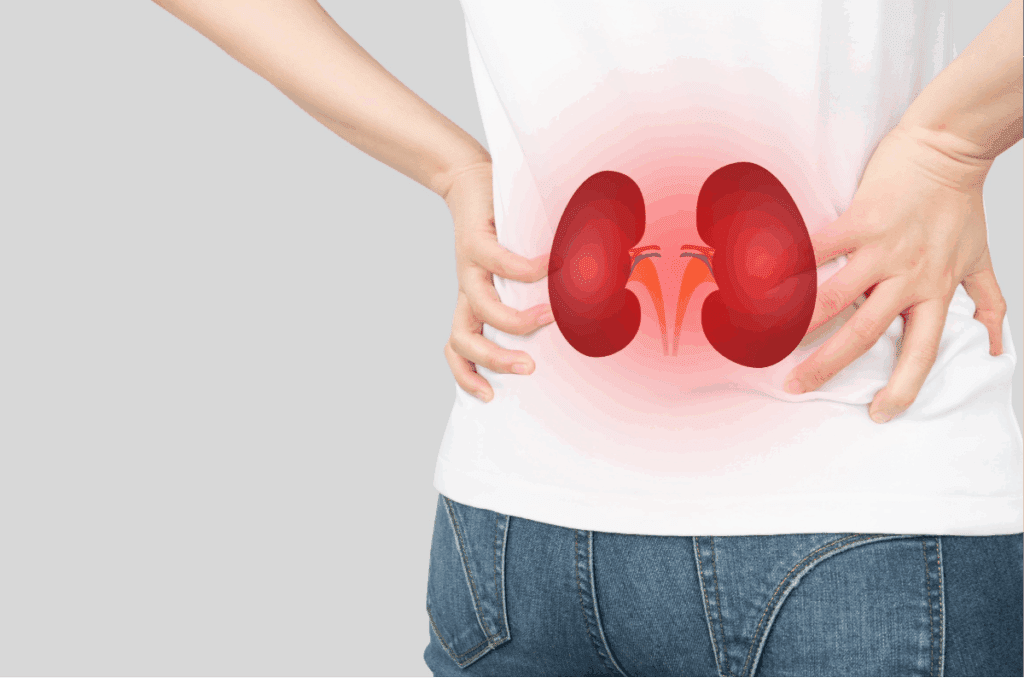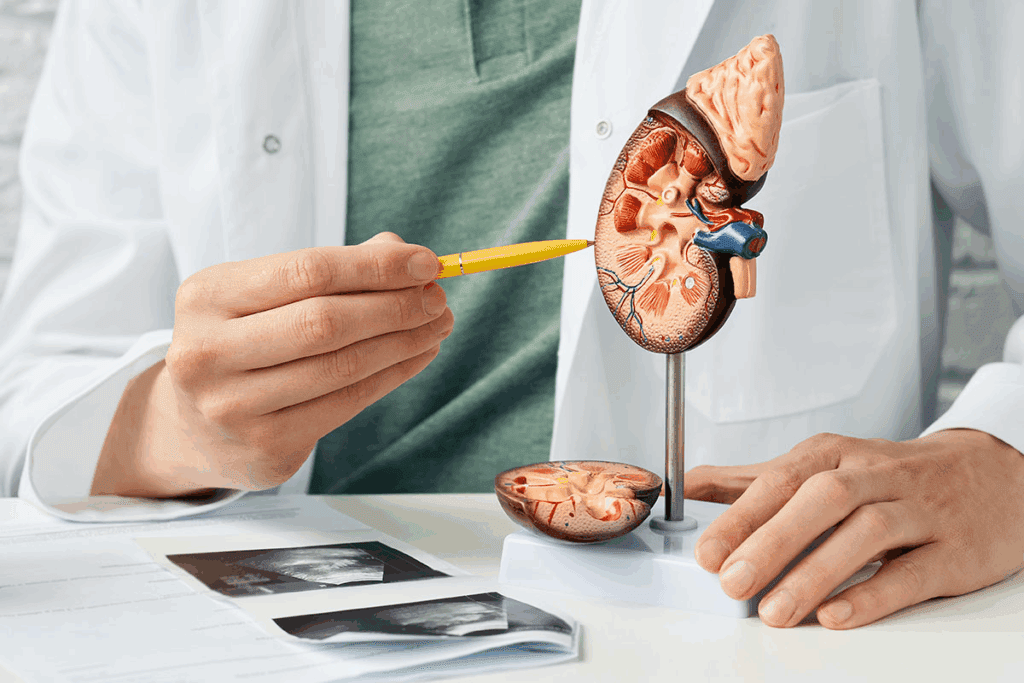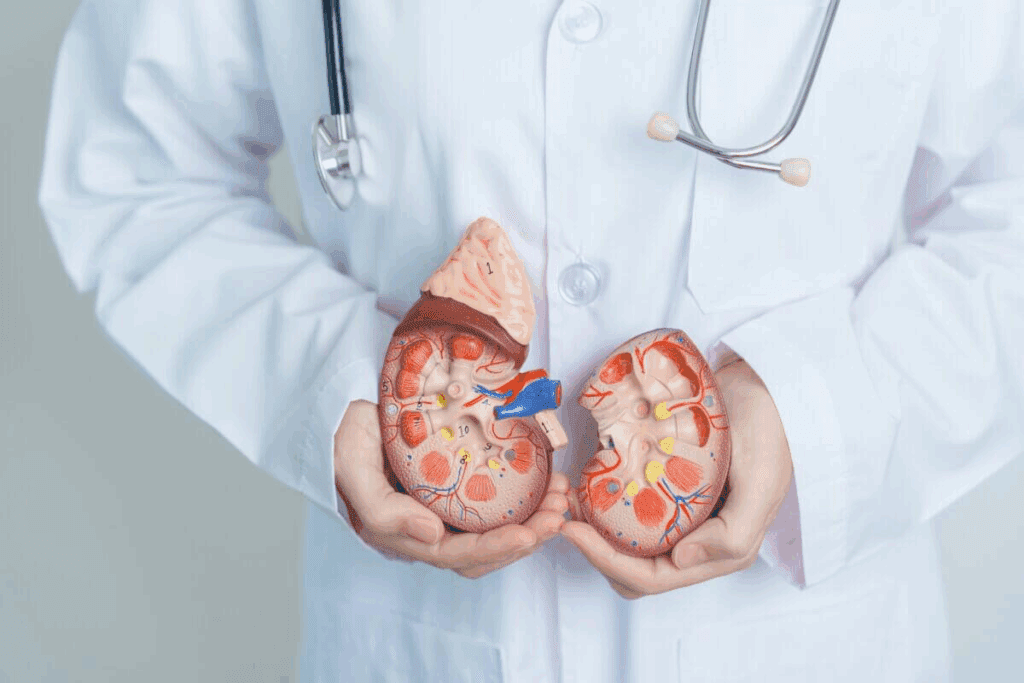
Kidney stones are a big health worry. They can turn into serious problems if they get infected.
Kidney stones are hard, pebble-like things that form in the kidneys. They happen when certain minerals in urine are at high levels. If not treated, they can cause severe issues like urinary tract infections (UTIs) and sepsis, a deadly condition blood infection from kidney stone.
It’s important to know the risk of sepsis with kidney stones. At Liv Hospital, we focus on care that’s based on evidence and centered on the patient to lower these risks.

Kidney stones, also known as renal calculi, come in different sizes and types. Their severity can vary a lot from person to person. These stones are hard deposits made of minerals and salts that form inside the kidneys.
The size of kidney stones can range from as small as a grain of sand to as large as a golf ball.
Kidney stones form when there’s an imbalance in substances like calcium, oxalate, and uric acid in the urine. This imbalance causes these substances to crystallize and form stones. Dehydration, diet, and certain medical conditions can increase the risk of getting kidney stones.
Men are more likely to get kidney stones than women, but women’s risk is rising. Knowing how kidney stones form and what they’re made of is key to preventing them and managing their symptoms.
The main symptom of kidney stones is severe, changing pain. This pain, called renal colic, can spread from the back or side to the lower abdomen or groin. Other symptoms include blood in the urine, nausea, vomiting, and painful urination.
When a stone blocks the urinary tract, it can cause infection or damage to the kidney. A large stone can block the flow completely, which is a medical emergency.

A big risk with kidney stones is getting a kidney infection. This can lead to sepsis, a life-threatening condition. When a stone blocks the urinary tract, it can help bacteria grow, leading to infections like pyelonephritis.
If bacteria get into the bloodstream, they can cause a blood infection from kidney stone. This can lead to kidney stones sepsis or septic kidney stone.
Quick medical help is key to avoid these dangers. Knowing how serious kidney stones can be is important for getting the right treatment and care.
Kidney stones can block the urinary tract, making it easy for bacteria to grow and cause infections. This blockage stops urine from flowing normally. It also lets bacteria multiply and spread.
A kidney stone can block the urinary tract, causing urine to stay in the system. This can put pressure on the urinary system, damaging its delicate tissues. The blockage can happen at different places, like the kidneys, ureters, or bladder. The size and location of the stone determine how severe the blockage is.
When the urinary tract is blocked, bacteria can easily grow. They stick to the walls of the tract and multiply in the urine. This growth can cause infections, which can get worse if not treated.
If a urinary tract infection is not treated, it can turn into a kidney infection, or pyelonephritis. This happens when bacteria move up the tract and reach the kidneys. Pyelonephritis can cause severe symptoms, including flank pain, fever, and nausea. It needs quick medical attention to avoid lasting damage.
Understanding the connection between kidney stones and urinary tract infections is key. It helps manage and prevent serious complications.
A kidney stone infection can turn into a serious problem by spreading bacteria into the blood. This process involves several key steps. These steps can lead to sepsis from a kidney stone, a condition that can be deadly.
The kidney-blood barrier keeps bacteria out of the bloodstream. But, a kidney stone can block the urinary tract. This causes urinary stasis, letting bacteria infect the urinary tract. If not treated quickly, bacteria can get into the bloodstream.
Bacteremia happens when bacteria get into the blood. With a kidney stone, this occurs when urinary tract infection spreads to the kidneys and blood. The stone provides a good place for bacteria to grow and blocks urine flow, raising the risk of kidney stone blood poisoning.
When bacteria get into the blood, the infection can spread throughout the body. This leads to sepsis, where the body’s response to the infection gets out of control. Sepsis is a serious condition that needs immediate medical help. Knowing the risks and spotting early signs of sepsis and kidney stones is key to avoiding this problem.
We need to understand how kidney stones can cause systemic infections. Taking action early is vital in managing infections from kidney stones and stopping sepsis.
Sepsis is a serious condition that can happen with kidney stones. It’s important to get medical help fast. We’ll look at what sepsis is, how the body reacts, and how it can get worse.
Sepsis is a dangerous condition where the body’s fight against an infection gets out of control. It can happen with kidney stones if a stone gets infected or if an infection in the urinary tract spreads to the blood.
Understanding the link between kidney stones and sepsis is key for early treatment. Kidney stones can block the urinary tract, making it easy for bacteria to grow. If bacteria get into the blood, they can cause sepsis, which needs quick medical care.
When an infection starts, the body’s immune system kicks in, causing inflammation. In sepsis, this inflammation gets too strong, affecting many parts of the body. It can even lead to organ failure if not treated right away.
Sepsis can get worse quickly, from mild to severe. Early signs include fever, fast heart rate, and breathing fast. If not treated, it can turn into septic shock, which is very dangerous.
It’s important to spot the symptoms of sepsis from kidney stones early. Look for fever, chills, pain in the side, and signs of a urinary tract infection. Quick medical help is needed to stop it from getting worse.
Kidney stone-related infections are a big worry. They show up differently in different groups of people. We look at how common these infections are and who is at risk. This helps us understand why they matter.
Studies show that about 10-15% of kidney stones get infected. The number of infected kidney stones is going up. This might be because of changes in diet, being overweight, and having diabetes. We dive into these numbers to grasp the problem’s size.
Going from infected kidney stones to sepsis is a big problem. More people are getting sepsis from urinary tract infections, like those from kidney stones. We talk about what this means and why we need to act fast.
The way kidney stone infections show up changes based on where you are and who you are. Different diets, lifestyles, and access to healthcare play a role. We look into how different groups are hit and what affects these differences.
It’s key to understand these trends to improve care and outcomes. By studying who gets kidney stone infections and why, we can tackle these issues head-on.
It’s important for people with kidney stones to know the signs of infection and sepsis. This way, they can get help quickly. We will talk about the key symptoms of infection and sepsis. It’s key to spot them early.
Infected kidney stones show certain symptoms early on. These include:
These signs mean a kidney stone might be infected. If not treated fast, it could get worse.
UTIs and kidney infections have their own signs. UTIs often show:
Kidney infections may cause:
Knowing these symptoms helps figure out how serious the infection is.
Sepsis is a serious condition where the body overreacts to an infection. Look out for these signs:
The table below lists the main symptoms of infection and sepsis in kidney stone patients:
| Condition | Common Symptoms |
| Infected Kidney Stones | Pain, fever, nausea, blood in urine, cloudy urine |
| Urinary Tract Infection (UTI) | Frequent urination, burning sensation, urgent need to urinate |
| Kidney Infection (Pyelonephritis) | Severe back or side pain, high fever, nausea, vomiting |
| Sepsis | High or low body temperature, rapid heart rate, rapid breathing, confusion |
It’s important to know the risk factors for sepsis in kidney stone patients. This helps prevent serious complications. We look at key factors that raise the risk of sepsis. This way, doctors can give better care.
Some medical conditions make sepsis more likely in kidney stone patients. These include diabetes, weakened immune systems, and chronic kidney disease. People with these conditions need extra care and quick treatment to avoid serious problems.
| Pre-existing Condition | Increased Risk |
| Diabetes | Higher susceptibility to infections |
| Immunosuppression | Reduced ability to fight off infections |
| Chronic Kidney Disease | Impaired kidney function complicating stone passage |
Abnormalities in the urinary tract can also raise sepsis risk. Issues like ureteral strictures, vesicoureteral reflux, and neurogenic bladder can block urine flow. This makes it easier for infections to spread.
“Urinary tract abnormalities can significantly complicate the management of kidney stones, increasing the risk of infection and sepsis.”
Delayed treatment and healthcare access problems can worsen sepsis risk. Quick action is key to stop kidney stones from turning into severe infections.
Antibiotic resistance is a big problem in treating infected kidney stones. We need effective ways to manage this, like using antibiotics wisely and finding new treatments.
Knowing these risk factors helps us care for patients with kidney stones better. This can lower the chance of sepsis.
It’s important to know how to diagnose and treat kidney stone infections. Quick action is key to managing these infections and preventing sepsis.
To diagnose infected kidney stones, we use several methods. We check the urine and blood for signs of infection. We also use ultrasound and CT scans to see the stone and any blockages.
A patient with symptoms will first get a full check-up. Then, we do tests to confirm the infection. Next, we use imaging to find out where and how big the stone is.
If a patient gets sepsis from a kidney stone, we act fast. We start antibiotic therapy right away. We also give fluid resuscitation and vasopressor support if needed.
Emergency rooms are key in spotting sepsis quickly. Quick action can greatly help a patient’s recovery.
Our treatment for infected kidney stones is detailed and team-based. We might need to surgically remove the stone if it’s causing problems. We also focus on pain management and hydration to help the patient get better.
We make a treatment plan that fits the patient’s needs. This includes the stone’s size, location, and any complications.
By taking a complete approach to diagnosis and treatment, we can better care for patients with infected kidney stones. This helps avoid serious issues like sepsis.
Stopping kidney stone infections is key to avoiding sepsis, a serious condition. We stress the need for diet changes and regular doctor visits to lower risks. Knowing the risks and spotting early signs helps people protect their health.
The future for those who have had sepsis depends on several things. These include how severe the infection was and how quickly treatment started. We help patients create detailed care plans to manage both immediate and long-term effects of sepsis. Keeping up with ongoing care and monitoring is vital for the best results.
Our goal is to prevent kidney stone infections and sepsis by focusing on prevention and quick action. We use the latest medical knowledge and put patients first. This approach helps people deal with these tough health issues.
Yes, kidney stones can lead to sepsis. This happens if they cause a urinary tract infection (UTI) that spreads to the bloodstream.
Kidney stones can block the urinary tract. This allows bacteria to grow and cause a UTI.
Symptoms include fever, chills, and a fast heart rate. Severe pain is also a sign.
Yes, a kidney stone can lead to a blood infection. This happens if a UTI spreads to the kidneys and into the bloodstream.
Risk factors include pre-existing medical conditions. Also, anatomical and functional urinary tract abnormalities are a concern. Delayed treatment and limited healthcare access are also risk factors.
Diagnosis involves a clinical evaluation and laboratory tests. Imaging studies are also used to confirm the presence of infection and sepsis.
Treatment includes emergency interventions for sepsis. Antibiotics are also used. Strategies to manage the infected kidney stone are part of the treatment plan.
Yes, kidney stones can cause kidney infections. This happens when they block the urinary tract and allow bacteria to grow.
The incidence of sepsis from kidney stones varies. It is a recognized complication, mainly in cases with UTIs.
Individuals with sepsis from kidney stones may need ongoing care. This is to prevent future infections and manage any long-term damage.
Yes, preventive measures include treating kidney stones promptly. Managing UTIs and addressing risk factors are also important.
Subscribe to our e-newsletter to stay informed about the latest innovations in the world of health and exclusive offers!
WhatsApp us